
(“raw” and “cooked” Pu er)
Week 5 Notes: Preparing for Pu er Workshop
| Author |
Book Title |
| By: Kevin Gascoyne, Francois Marchand, Jasmin Desharnais and Humo Americi |
Tea: History, Terroirs, Varieties
|
| Content |
Notes |
Pg. # |
| History |
|
|
| Tang dynasty 618-907 |
· Pu-er was boiled and added to soup as flavoring
· Famous for history and curative properties |
66 |
| Name is from the town of Pu er in Yunnan Province in SW China |
· Growers from neighboring mountains brought harvest to be sold and sent elsewhere.

|
“ |
| Tea cakes |
· Process to help with transport by horseback. |
“ |
| Prevent others from usurping.
· Bureau of Standard Measurement of Yunnan Province defined Pu er as |
· Fermented green tea products obtained from the large leaves of tea trees harvested in Yunnan Province
Not all experts agree with definition. It is however partially justified by the quality of the tea tree grown in Yunnan. |
“ |
| De Ye
|
Means,” large leaves” Grown in Yunnan |
67 |
| Best Pu-er |
Mountain ranges located in Xishuangbanna
· Youle
· Banzhang
· Manzhuan
· Yiwu
· Mensong
Renowned for tea production
· Banpen
· Yiban |
“ |
| Market trends |
· Time to age Pu er creates a rarity to the product
· Created a rise in price and opportunity
· Year 2000- many people invested in plantations
· Year 2007- Quick growth of Sheng Pu er led to a peak, fall, and speculative bubble burst.
· Investors pulled out and now the market seems to be stabilizing
· Rarity of product still demands a high price |
“ |
| Sheng and Shou: Two parents of the Pu Er tea family |
|
66 |
| Sheng = “Raw” Pu er
· Best tea comes from all wild tea trees, which are several centuries old. |
· One of the first teas to appear in China
· Fermented 10-50 years
· Not considered fully mature until they have been aged for 30 years. Labeled as “vintage”. |
66 |
| Shou = “Cooked” Pu er |
· 1970, increase in popularity led to a new method to bring the tea to market faster.
· Shou is processed the same as Sheng; the fermentation process is faster, and occurs over 45-60 days.
· Made for immediate consumption and the taste doesn’t get significantly better with aging.
· Usually made with lower quality tea leaves and almost exclusively from plantations. |
66 |
| Different ways to shape Pu er Tea
· Distinguishing features |
· Bing cha (the cake) 12 oz
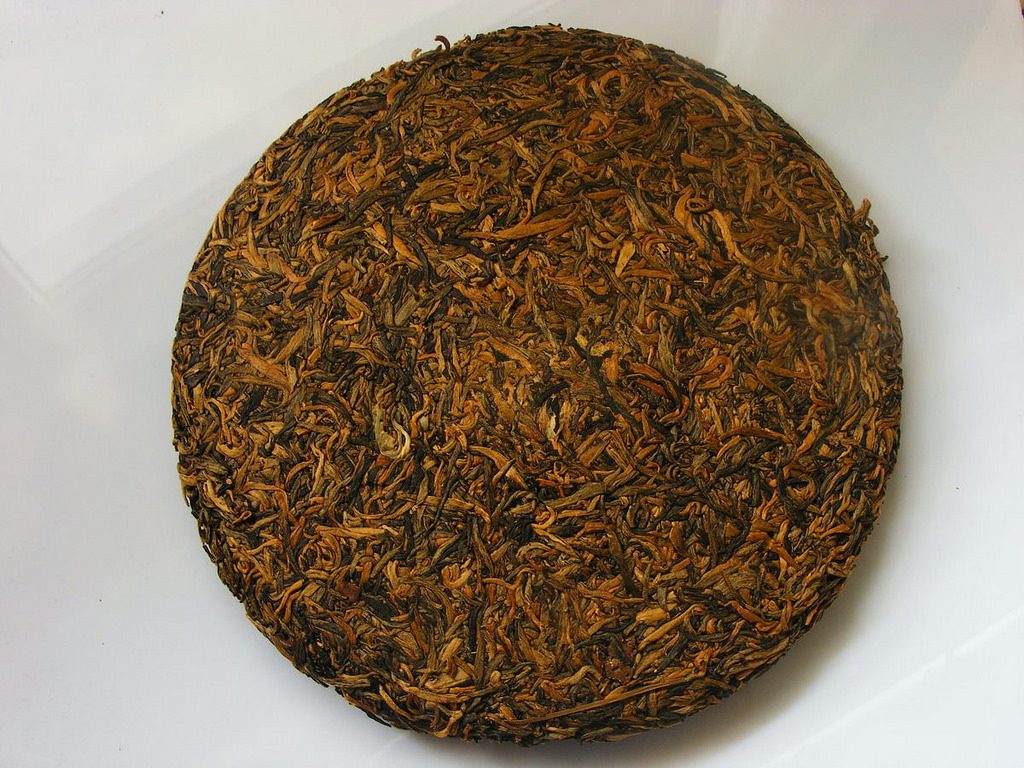
· Zhuan cha (the brick) 9 oz

· Tuo cha (the nest) 3.5-9 oz
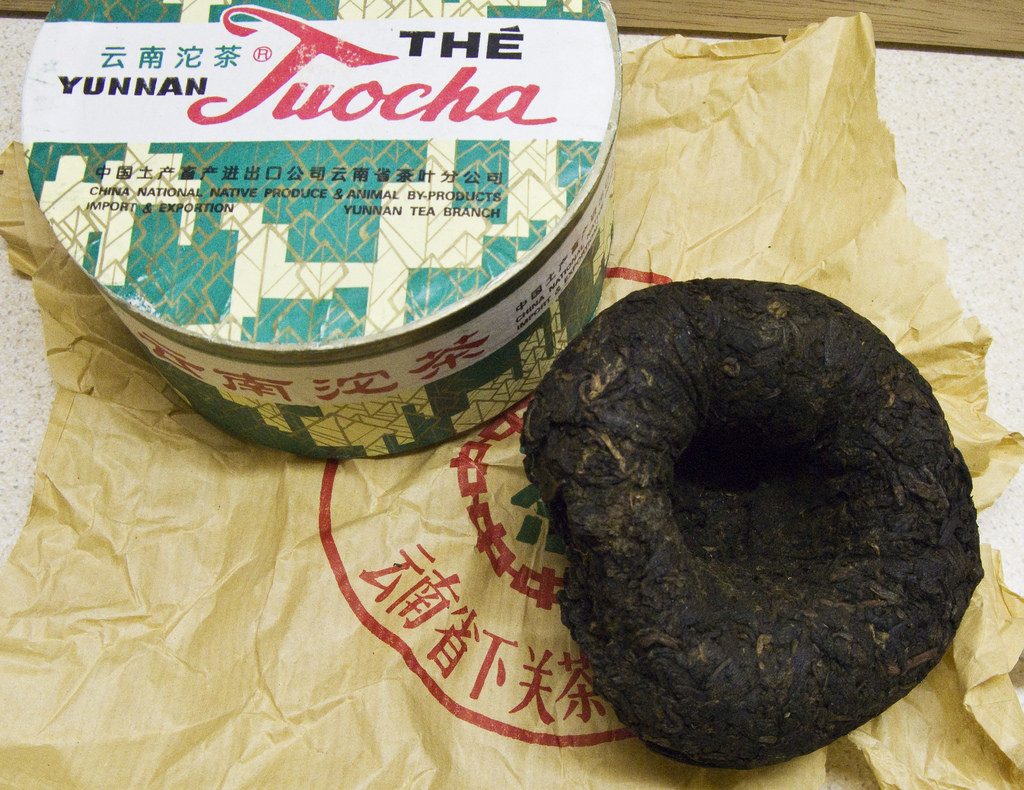
· Jin gua (the pumpkin) comes in several sizes
· “The Mushroom” roughly 8 oz
· “The Cube” 1/6 oz
· Can also be made into custom or decorative shapes, like a Buddha or pig for specific events.
**Couldn’t find photos that were labeled for reuse for the cube, mushroom and pumpkin shape. |
67 |
| Nei Fei (Trademark) |
· A cake of Pu er will usually be marked with a nei fei to indicate the place where the tea was processed.
· Usually a small piece of paper placed on the leaves after being compressed. |
|
| Processing of Pu er Tea
1. Maocha
2. Sheng processing or Shou |
· The first step in the process is to create Maocha.

1. Picking: the quality of Pu er depends on the part on the plant material used. A grading system from one to nine defines the size of the leaves which are used.

2. Withering: processing Pu er teas begins with withering the freshly picked tea leaves. The leaves are spread in the sun for a few hours. In industrial processing the leaves are spread on racks in a room and heated with hot-water radiant heat.
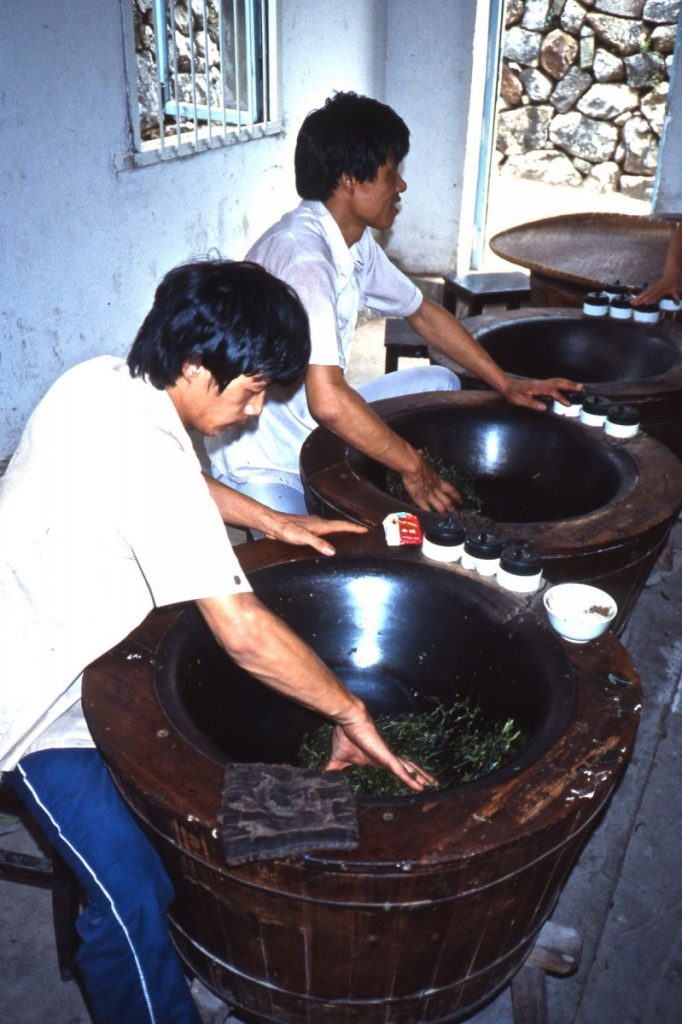
3. Heating: Small-scale heating takes place in pans and lasts for two to three minutes. The batches of leaves are far bigger than those used when producing green teas. The pans are usually heated by means of wood fires.
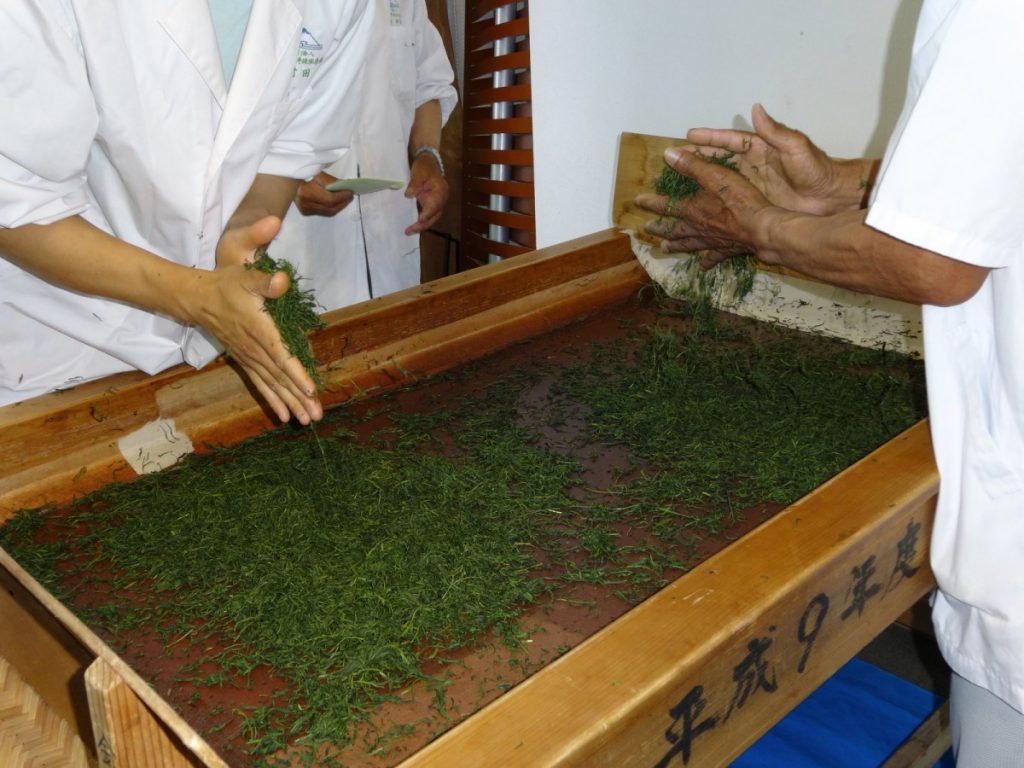
4. Rolling: The leaves are then rolled by hand on a bamboo mat until they form a large ball. In industrial processing, th leaves are rolled in the same type of round roller press as used for black teas or for curly leaf green teas.
5. Second Heating: Sometimes the leaves are heated a second time in the pans, also for two to three minutes.
6. Second Rolling: The same method is used as for the first rolling: by hand on a bamboo mat (the traditional method) or rolled in a round roller press (the industrial method).
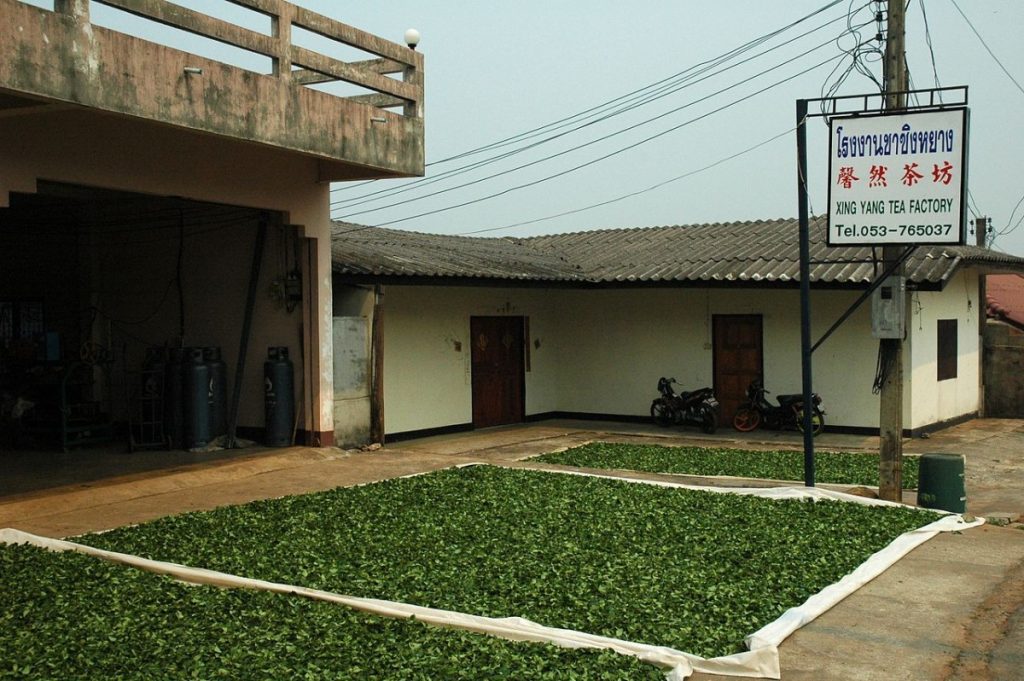
7. Drying: Distinguishing features after the second rolling, the leaves are dried in the sun or in a temperature and moisture controlled greenhouse. In industrial processing, the leaves are dried on a conveyor belt that passes through a heating machine.

8. Sorting: Next, all residue is eliminated form the leaves by means of manual sorting.
9. Moacha is then ready: The people who produce Moacha sell it to specialized processors who then compress the leaves into different shapes.
· The highest quality leaves are usually reserved for Sheng Pu er, maocha can be used to produce both types of Pu er teas. |
68 |
| Sheng Processing |
1. Sorting and Grouping: Separating the leaves into different grades is done by hand or by machine. The leaves are sorted into nine principal grades, the first containing the smallest leaves and the ninth the largest. At this stage the leaves from different origins may be grouped together.
2. Compression: The leaves are split into groups that correspond to the desired weight of each cake to be formed. They are then sprayed with steam to hydrate and soften them so they are malleable. Then the paper indicating the trademark of the tea is inserted into the leaves. The moist leaves are then placed in a cloth. According to tradition they are then pressed under a stone. A hydraulic press is sued for mechanical compression.
3. Drying: Once the cakes are compressed they are laid out to dry in the air without any cloths so any residual moisture can escape. In industrial processing sometimes the cakes are placed in a room hated by hot water pipes to speed up the drying process. The cakes are then returned to their weight prior to dampening. Packaging: Traditionally the cakes were wrapped individual identifying paper, group the cakes in lots of seven (called tong) and package each in a dried bamboo bark. Each tong was placed in a bamboo basket as part of a lot of six (called jin).
|
70 |
| Shou Processing |
To produce Shou the fermentation process is accelerated by exposing the maocha leaves to high heat and humidity
1. Fermentation: the leaves are placed in a room and covered with water and a cloth. They are then exposed to high heat and humidity for 45-65 days. During this stage they will be turned over several times.
2. Sorting: Once the accelerated formation is over, the leaves are first sorted by machine then by hand in order to eliminate unfermented leaves.
3. Compression: Next, the same compression process as for Sheng Pu er is used. However few Shou Pu er teas are compressed by the traditional method. Hydraulic pressed are generally used. Once all the stages are complete it is wise to wait at least three months before drinking the tea produced to allow the fermentation process to stabilize. |
71 |
| Aging Pu er tea |
The conditions during the aging process can greatly affect the taste of the end product. The temperature should ideally be maintained between 68-86 degrees F. It does not have to be kept constant. At temperatures below 68 degrees F, the aging process will take much longer.
Ideal humidity is between 60-70 percent, in a dark room, where they will not be exposed to light and has good air circulation.
Should be kept away from other strong aromas they can absorb (spices, coffee, etc)
Ideally Sheng and Shou should be kept separate. |
|
| Yunnan Qi Zi Bing Cha |
· In the world of tea, some methods represent a tradition or particular way of thinking.
· Cakes of Pu er are inscribed Yunnan qi zi bing cha, which means “the tea cake of the seven sons of Yunnan

· Seven is a lucky number for the Chinese
· The use of plural implies that the family will produce many sons which implied good fortune.
· When one buys a cake of Pu er you are also buying a promise of prosperity.
· The round shape represents the full moon. Which for the Chinese symbolizes a gathering of a whole family. |
|
| Pu er Infusion tips |

Sheng Pu er teas less than 10 years old
Appearance of the leaves: Longish leaves or compressed shapes (nest, cube, cake, brike)
Quantity: 1/12 oz (2.5 grams) of tea to 1 cup (250 ml) water. Or 1 teaspoon per cup.
Temperature: 194-203 degrees F.
Length of Infusion: 3-5 minutes
Extra: Rinse for 5 seconds. If the leaves are broken and smaller shorten the infusion.
Shou Pu er (any age) and Sheng Pu er over 10 years old
Appearance of the leaves: Longish leaves or compressed shapes (nest, cube, cake, brike)
Quantity: 1/10oz (3 grams) of tea to 1 cup (250 ml) water. Or 2 teaspoon per cup.
Temperature: 203 degrees F.
Length of Infusion: 4-6 minutes
Extra: Rinse twice for 5 seconds. If the leaves are broken and smaller shorten the infusion. |
209 |
| Properties of Pu er |
· Historically used as a dietary supplement by many nomadic tribes and ethnic groups living in regions in Asia. These people ate mostly very fatty yak meat. The tea helped to counteract the high fat content. The purging qualities of Pu er are recognized as helping specifically to regulate the body and stimulate digestion. |
251 |
| Chemicals responsible for the dark brown color of Pu er |
Thearubigins Red/Brown color
Theaflavins Yellow color
|
|
| Author/Editor |
Book Title |
| Yong-su Zhen
Zong-mao Chen
Shu-jun Cheng
Miao-Ian Chen |
Tea: Bioactivity and Therapeutic Potential |
| Content |
Notes |
Pg. # |
| Post “fermented” tea |
The main compounds found in Pu er tea are
· (E)-2-hexenal
· (E)-2- pentenal
· (E,Z)-2,4-heptadienal
· Ionones and their oxides
· (Z)-jasmone
*These compounds are reported as being produced during the microbial-fermentation. |
104
(4.4) (4.4.1) |
| Wang et al. 1991 |
Studied the changes of the aroma compounds of Fuzhuan brick tea during the fungal growing process and found almost all:
· aldehydes
· ketones
· 2,5-dimethyl pyrazine
· 2,6- dimethyl pyrazine
Especially increased during fungal growth
· (E,Z) 2,4-heptadienal
· Furfural
· (E,E)-2,4-heptadienal
· (E,E)-2,4-octadienal
Presumed the increased compounds contributed to the formation of the fungus flower flavor of Fuzhan brick tea. |
|
| Aroma Compounds in Dark Teas
Study done by Wang et al. 1991 |
*Manufactured by orthodox pile-fermenting (OPF)
*Sterile pile-fermenting (SPF)
· Experiment found that OPF sample contained more terpenols and phenols, while the SPF sample contained more aldehydes and ketones. |
|
Sources
“500px-Caffeine_metabolites.svg.png (500×422).” Accessed March 6, 2017. https://upload.wikimedia.org/wikipedia/commons/thumb/3/32/Caffeine_metabolites.svg/500px-Caffeine_metabolites.svg.png.
“909px-Thé_pu-Erh.jpg (909×768).” Accessed March 7, 2017. https://upload.wikimedia.org/wikipedia/commons/thumb/0/06/Th%C3%A9_pu-erh.jpg/909px-Th%C3%A9_pu-erh.jpg.
“1280px-XingYangTeaFactory_Leaves.JPG (1280×851).” Accessed March 7, 2017. https://upload.wikimedia.org/wikipedia/commons/thumb/e/ed/XingYangTeaFactory_Leaves.JPG/1280px-XingYangTeaFactory_Leaves.JPG.
“6890.jpg (448×336).” Accessed March 7, 2017. http://www.gokunming.com/images/blog/6890.jpg.
“3326950536_ec2594db73_b.jpg (1024×790).” Accessed March 7, 2017. https://c1.staticflickr.com/4/3596/3326950536_ec2594db73_b.jpg.
“5051158821_52a927592b_b.jpg (1024×689).” Accessed March 7, 2017. https://c1.staticflickr.com/5/4153/5051158821_52a927592b_b.jpg.
“5459498068_ebeed62fe1_b.jpg (1024×768).” Accessed March 7, 2017. https://c2.staticflickr.com/6/5295/5459498068_ebeed62fe1_b.jpg.
“Cup of Pu Erh Tea – Google Search.” Accessed March 6, 2017. https://www.google.com/search?q=cup+of+pu+erh+tea&biw=1271&bih=489&source=lnms&tbm=isch&sa=X&ved=0ahUKEwirqrWO9MDSAhULh1QKHblUBe0Q_AUIBigB#q=cup+of+pu+erh+tea&tbm=isch&tbs=sur:fc&*&imgrc=kwEyROhofPI03M:
“Fang_cha.jpg (500×375).” Accessed March 7, 2017. https://upload.wikimedia.org/wikipedia/commons/3/39/Fang_cha.jpg.
“Farmhouse-Hand-Fresh-Tea-623796.jpg (960×640).” Accessed March 7, 2017. http://maxpixel.freegreatpicture.com/static/photo/1x/Farmhouse-Hand-Fresh-Tea-623796.jpg.
“Free Image on Pixabay – Tea Cake, Pu’Er, Photography.” Accessed March 7, 2017. /en/tea-cake-pu-er-photography-504706/.
Gascoyne, Francois Marchand, Jasmin Desharnais, and Hugo Americi. Tea History Terroirs Varieties. A Firefly Book, 2011.
Hua-Fu, Wang, You Xiao-Qing, and Chen Zong-Mao. “The Chemistry of Tea Volatiles.” In Tea:Bioactivity and Therapeutic Potential, 104. Taylor and Francis, 2002.
“Workers_heat_tea_leaves_in_tourist_area_of_Chinese_plantation.jpg (1199×1800).” Accessed March 7, 2017. https://upload.wikimedia.org/wikipedia/commons/4/4f/Workers_heat_tea_leaves_in_tourist_area_of_Chinese_plantation.jpg.












